Remembrance Forum for Anfal Surviving Women, Rizgary
HAUKARI e.V. supports the self-organizations of survivors of political and social violence – especially women survivors of the 1988 Anfal operations – in their fight for justice and recognition.
Table of Contents
Development of the Forum of Remembrance
In the Remembrance Forum project, Anfal survivors in the former resettlement camp Sumud – now renamed Rizgary – in the Germian region in south-eastern Kurdistan-Iraq are committed to creating a self-designed and managed memorial and meeting place. They want to create a place that represents their specific experience during and after Anfal – their suffering but also their strengths and their pride of survival today – and gives them space for shared mourning, mutual consolation and joint activities.
Here they want to keep the memory of their disappeared and murdered relatives alive through the exhibition of memorabilia, documents and photos and bring their situation and demands to the public. The forum is intended to open up spaces for dialog with the younger generation and other social groups in Iraq.
In the Remembrance Forum project, Anfal survivors in the former resettlement camp Sumud – now renamed Rizgary – in the Germian region in south-eastern Kurdistan-Iraq are committed to creating a self-designed and managed memorial and meeting place. They want to create a place that represents their specific experience during and after Anfal – their suffering but also their strengths and their pride of survival today – and gives them space for shared mourning, mutual consolation and joint activities.
Here they want to keep the memory of their disappeared and murdered relatives alive through the exhibition of memorabilia, documents and photos and bring their situation and demands to the public. The forum is intended to open up spaces for dialog with the younger generation and other social groups in Iraq.
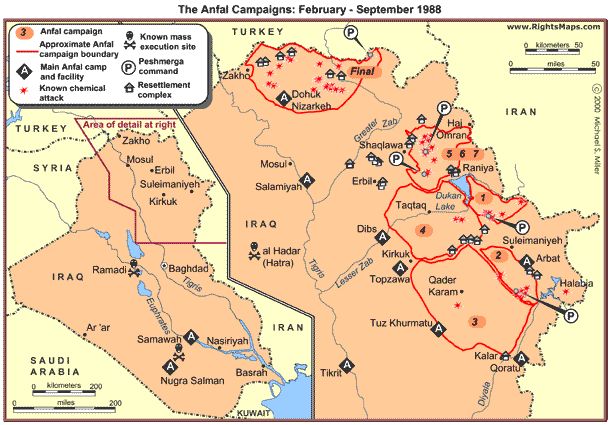
Background: The Anfal Operations 1988
In 1988, the Iraqi regime carried out a large-scale military operation against Kurdish areas in the north of Iraq under the code word “Anfal”. More than one hundred thousand men and women were abducted, murdered and buried in mass graves. The individual fate of most of them remains uncertain to this day.
Thousands of Kurdish villages were razed to the ground. Thousands of women, men and children were imprisoned for months in camps and prisons; many died of hunger and exhaustion. After their release, the survivors were taken to forced resettlement camps. The city of Rizgary, which today has a population of 40,000, grew out of one such resettlement camp.
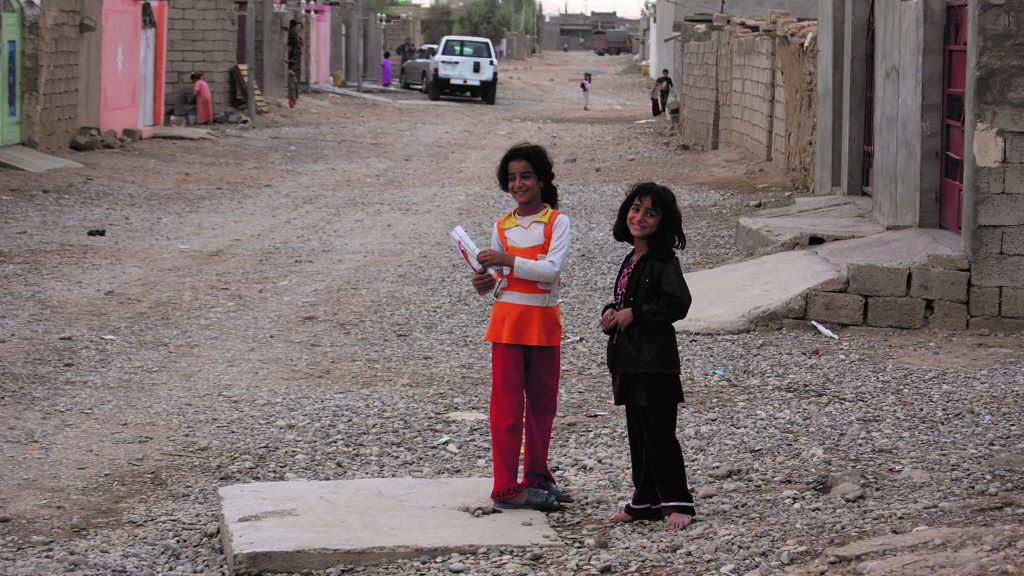
The Anfal Surviving Women's Committee for a Remembrance Forum in Rizgary
With the founding of the “Committee of Anfal Surviving Women for a Forum of Remembrance in Rizgary” in 2009, more than 100 women were initially continuously active in the project, meeting regularly, discussing the design of the forum with artists and architects and with the Kurdish regional government about financing and construction.
In numerous public events, they were also able to gain broad support for the project among men and young people in the region and brought their situation and demands into the public debate. Through events and social and cultural offerings, especially for the younger generation in Germian, they anticipate the future use of the memorial forum as a meeting place and emphasize that the forum, initiated and supported by women, should become a social place for all people in the region.

© Zeller & Moye
Anfal survivors and other project participants came to Germany several times as part of the project, visited memorials to the victims of the Holocaust and the Nazi regime and exchanged ideas with German artists and representatives of remembrance projects. In addition, Anfal surviving women began an exchange with women from Rwanda and Bosnia about survival strategies after extreme violence.
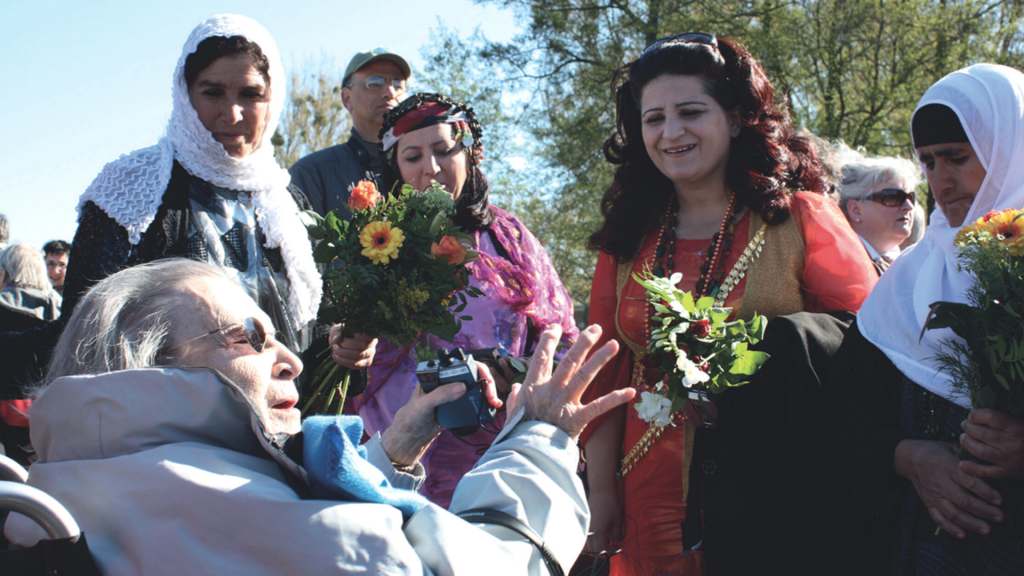
With the initiative for a remembrance forum, Anfal surviving women are taking a step out of their long-standing state of waiting, actively and jointly dealing with their experiences of violence and loss and strengthening their self-help structures. They counter their public representation as passive victims and symbols of suffering with their own memories, stories and strengths and actively engage in the social debate about the violent past.
Implementation and Current Status
The discussions with the Kurdish Regional Government about the financing and construction of the project were tough. There was some resistance to a memorial site from below, which contrasts with the prevailing ideas of a monumental culture of remembrance of the Kurdish tragedy. In the meantime, the Rizgary City Council has granted a building permit on a central plot of land opposite the cemetery where several hundred Anfal victims are already buried. In the fall of 2013, the Ministry of Anfal and Martyrs of the Kurdistan Regional Government provided funding for the construction of the memorial forum.
For more detailed information on the history and design of the memorial forum, click here.
Anfal Documentation Centre Maryam
Due to the renewed conflict situation and the ongoing financial crisis in the Kurdistan Region of Iraq since 2014, the start of construction has been delayed. Anfal surviving women from Rizgary continue to work for the remembrance forum. HAUKARI e.V. accompanies them in this process, creates spaces for discussion and exchange and decentralized commemorative actions. For example, HAUKARI e.V. opened the Anfal Documentation Centre Maryam in Rizgary in 2022. The building was originally built by the Ba’ath regime and used to command the forced resettlement camp Smud. In 1991, Peshmerga fighters conquered it in the course of the Raparin uprisings. Over the years, it has been inhabited by Anfal survivor women and their children, used as an office by the PUK Women’s Union and most recently as a police station.
Today, the building houses a museum, a documentation centre and a contact point for Anfal survivors. The centre collects and exhibits mementos of victims of the Anfal operations and records the stories of relatives and survivors in sound and vision. The house is also used as a workshop and workplace for the realization of the Anfal Remembrance Forum. It was named after Maryam Salih, an Anfal survivor from Garmian, who lost her fiancé in the violence and waited in vain for his return throughout her life.
Project Components
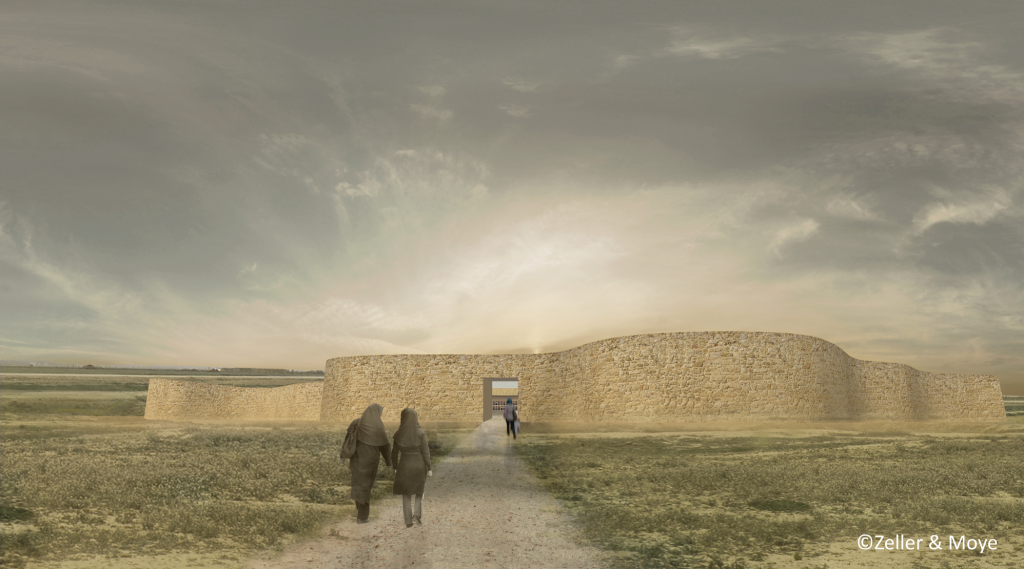
© Zeller & Moye
Architecture Design
After a discussion process over five years and many different designs for the building, the building design by German architects Ingrid Moye/Christoph Zeller was enthusiastically received by all those involved in October 2013. The design incorporates all the wishes of the Anfal surviving women: it integrates the assembly hall, exhibition areas and social and rest rooms into a protective outer wall, combining traditional materials with modern forms. In this way, the building blends into the Germian landscape, yet is striking and takes into account the women’s need for visibility.
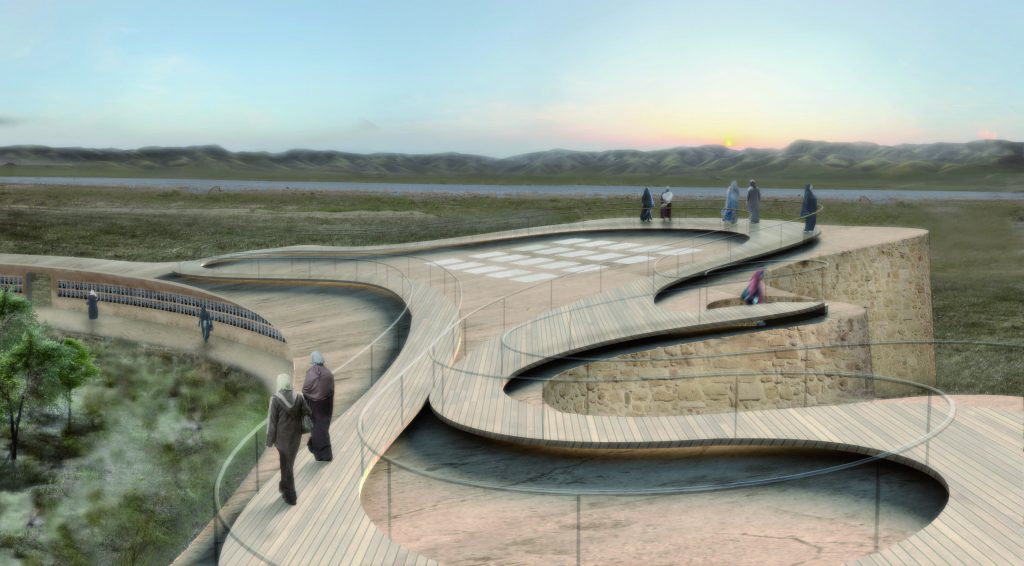
© Zeller & Moye
The accessible roof provides a view of the cemetery opposite and thus creates a connection to the victims. The sheltered interior offers space for commemoration, resting and social activities. The outer wall acts as a reminder of the infamous Nugra Salman prison, where many women were imprisoned during Anfal, while also recalling the protective walls of the traditional houses in the villages of Germian that were destroyed during Anfal. “Behind the prison walls, a new life opens up,” comments one Anfal survivor. And: “Here we can mourn together and hold funerals, but also celebrate the weddings of our children”. The building design thus reflects the women’s painful journey from victims to survivors.
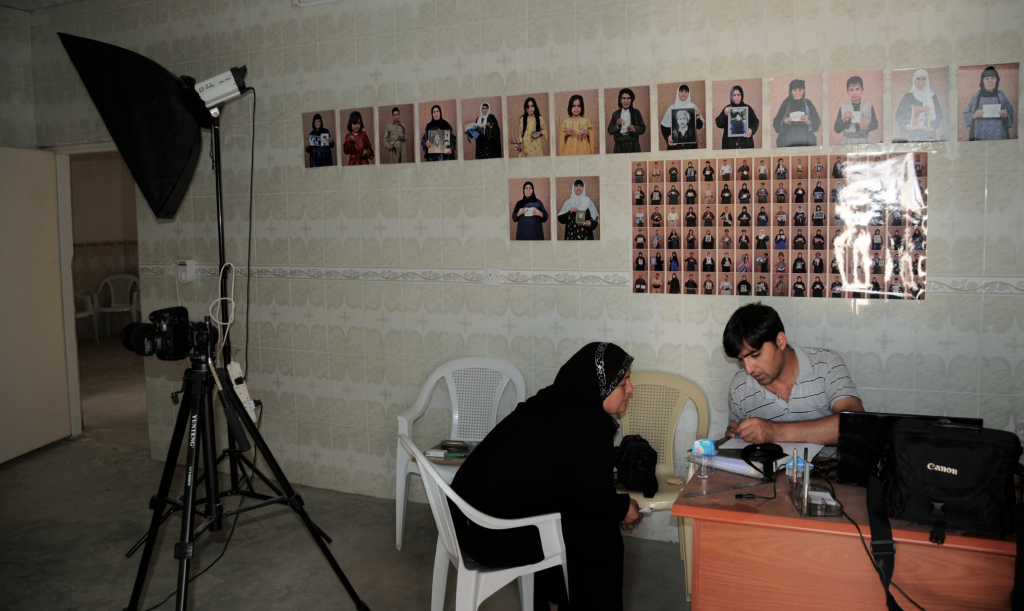
The Photo Documentation
The centerpiece of the remembrance forum will be a permanently installed exhibition of portrait photos of Anfal survivors with memorabilia of their disappeared and murdered relatives.
With the advice of Prof. Michael Fehr, local photographers have been taking portraits of Anfal survivors in regular photo sessions in Rizgary and the surrounding area since 2010. For the background of the photos, a transportable clay wall was built in the style of the usual local house walls.
The mobile photo studio is set up on announced dates in Rizgary and surrounding areas in order to reach Anfal survivors who live in remote villages and are unable to travel due to illness and age.

Anfal survivors bring photos, ID cards, items of clothing or personal belongings of their loved ones. If they have no mementos, they write the names of the victims in the palm of their hand or on a piece of paper. Together with the photo, their details, short biographies and the history of the memorabilia are documented for the archive of the Remembrance Forum.
The approximately 1200 photos taken so far will be followed by several hundred more. The photos will form the core of the memorial as a gallery in the interior of the memorial forum.
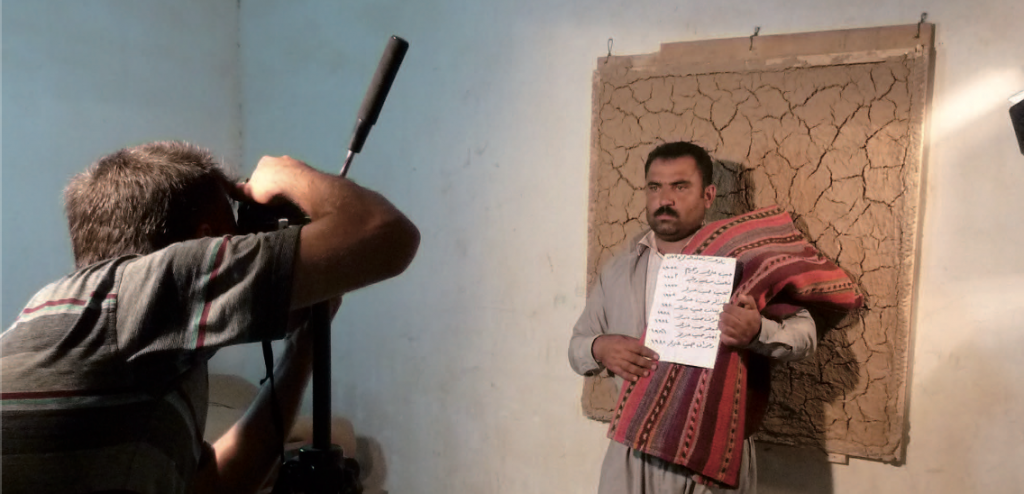
Not only Anfal surviving women, but also numerous men have had their portraits taken. While they were initially skeptical about a memorial by and for women, they now see the memorial forum as an opportunity to erect a monument to their disappeared and murdered wives, mothers and daughters. They bring their own specific memories and experiences into the discussion and design process.
The photos tell the story of the murdered/disappeared as well as that of the survivors, forming a bridge between past and present and reflecting the shift in focus from mourning the dead to honoring the survivors in the Anfal survivors’ remembrance work. The regular public photo opportunities in and around Rizgary have also become spaces for dialog. Here Anfal survivors meet, tell each other their stories and complete the documentation together. Many come regularly to the events to meet other survivors.
From Focusing on the Victims to Honouring the Survivors
The constantly growing collection of photos has been shown publicly several times in various cities in Kurdistan-Iraq. Together with the photos, models for a statue of a woman were exhibited at the memorial forum – made by Kurdish artists according to specifications and in close consultation with the Anfal survivors.
The exhibitions have publicized the project in Kurdistan-Iraq, broadened the discussion about the design of the forum and contributed to public awareness of the situation and the demands of Anfal surviving women.
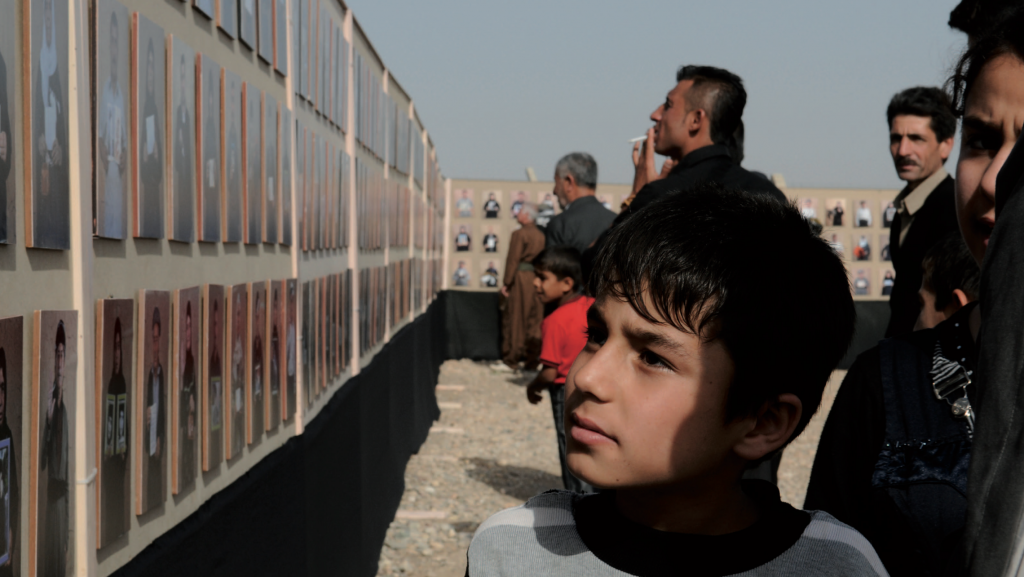
On the anniversary of Anfal in April 2011, the exhibition was shown as part of the public commemorations at the Rizgary cemetery. There are 187 Anfal victims buried here – most of them anonymously. Many hundreds more victims/dead are to be buried here once the mass graves have been opened. In addition to mourning the dead, the exhibition also succeeded in creating space for the survivors to be honored at the official commemoration ceremonies.
In June 2012, the photos were shown in the former security prison of the Baath secret service in Sulaimania. Today, the building houses a museum commemorating the crimes of the Baath regime and the Kurdish uprising against Saddam Hussein. A permanent exhibition on the Remembrance Forum project in Rizgary is now to be set up here.
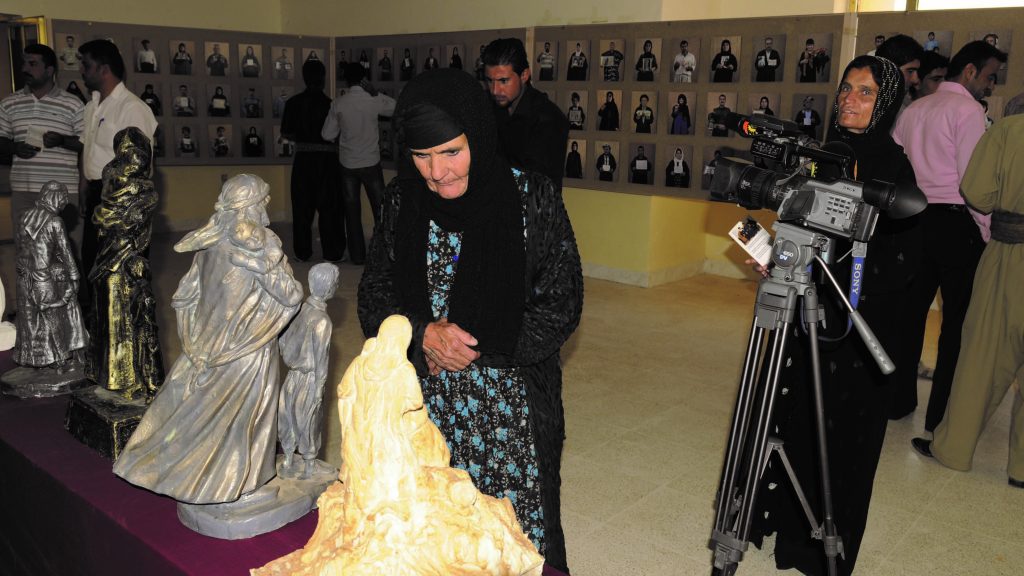
Figural Statue of a Woman
In front of the entrance to the Forum of Remembrance, a life-size figurative statue of a woman will represent the specific experience of women among the Anfal survivors and mark the Forum as a place initiated and designed primarily by women.
In discussions with local artists, the Anfal survivors developed the idea of a life-size statue of a woman with a dead child in her arms and a living child at her side. The figure is intended to express both the pain and grief, but also their strength and pride of survival. Around 15 models were created in several rounds of tenders. So far, none of the designs has convinced the women – the joint design process continues. The process of sculpting their memories gives the women a forum to articulate their contradictory feelings between grief and hope, despair and pride.
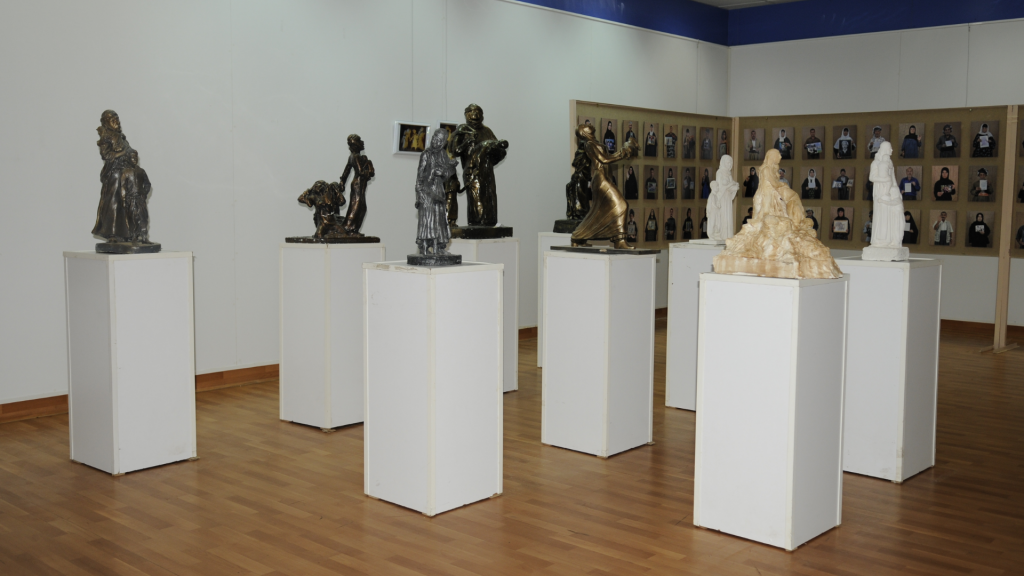
Designs for Statue
Sponsors and partners
The project was suppoerted by the Federal Foreign Office of Germany from 2014-2017.